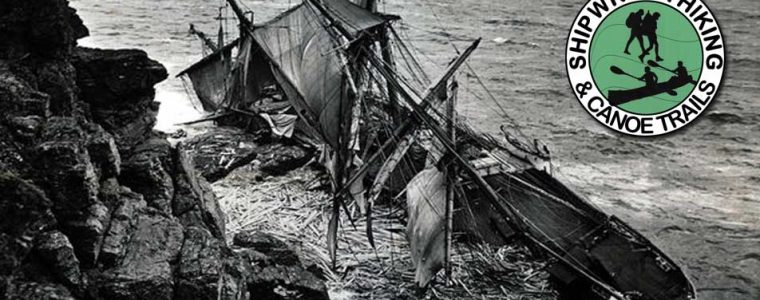
Shipwrecks from Port Alfred to Waterloo Bay.
A hiker must take into consideration that most of the ships that sank in the early 1800’s will not be visible anymore. They were built from wood/steel and masts that stick out of the water would be covered in marine growth now.
Some of the vessels that offloaded in the Kowie area were Barques, Flutes, Brigs, Schooners and later sail and steam vessels, which were some of the ships that ran aground.
The boiler of the Tug Victoria that operated on the Kowie River in 1870 can sometimes be seen on Eastern beach, 1km from Kowie River towards Rufane. It’s mostly covered with sand and after rough seas and high tides it’s washed open. Tug Victoria was mainly used to ferry passengers up & down the river as far as the Mansfield Mill because of her shallow draught. She also towed the sailing ships around port. The story goes that the Captain was owed money by the owner William Cock of the Tug Victoria and he would not pay him, so one morning the captain steamed the tug at 4am out to sea and run it onto the rocks at Eastern beach in revenge and they assumed that he went to look for diamonds in the Kimberley fields as he was never seen again. In 1863 the first Tug Prince Alfred arrived but after 6 months she was sold as she was unfit for river use.
In modern days the South African Maritime Safety Authority requires that all ships that run aground, if they cannot be salvaged, they have to be removed from the site. They do this by cutting them up and removing them. Ships that get into trouble far off the coast will sink in deep water, if they are not towed to port.
The info below is about a few of the ships that ran aground in the Riet River, Kleinemonde and Three Sisters areas.
SS Craigellachie British steel screw steamer of 3,271 tons – built in 1899 at A. Roger & Co. Port Glasgow.
Wrecked slightly east of Riet Point, 16km east of the Kowie River near Three Sister Rocks on 10th May 1900, while on a voyage from Hull to Durban with a cargo of coal. No lives were lost. Hikers along the beach may find pieces of coal from the ship.
SS Kilbrennan steel screw steamer of 2,331 tons.
Built in 1903 on the River Clyde in Scotland. With a crew of 30, it struck a reef on the 28th March 1907 and sank in 18m of water close to Three Sisters. She was on her way to Diego Saureg Madagascar with 600 tons of coal from Barry in Wales.
Umvolozi British steamer of 1,775 tons built in 1889 by J. Laing Sunderland, owned by Bullard King & Co and commanded by Captain H Clarke.
Wrecked 300m east of Kleinemonde River mouth on 12 April 1890 while on a voyage to Natal with cargo of 6 railway coaches, sleepers and mining machinery. The crew & 2 passengers were safely landed. She traded between London & Natal.
SS Finland steel screw steamer built in1886 of 1,363 tons by Dumbarton owned by Union Line, commanded by Captain J Freebody.
Wrecked between Kleinemonde & Great Fish Point on 26th April 1887 while on a voyage from Cape Town to Mauritius, with a full general cargo including machinery for the goldfields and a box containing 2,000 sovereigns to pay the Army. No lives were lost & all the cargo was saved.
John 1825.
A settler by the name of John Bailie tried to see if he could navigate the Fish River out to sea and back into the river with a small settlers boat, but he ran aground. He gave up the idea of trying to see if the Fish River would be used as a port. The biggest problem with the river was the fast flowing water going out with the tide.
